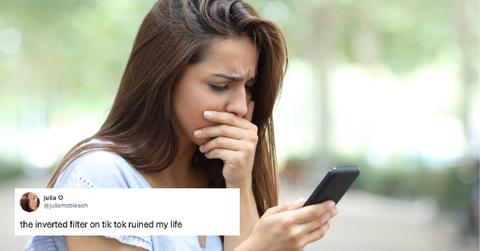Having a Good Self-Esteem Day? Don’t Open the Inverted Filter on TikTok
Updated Aug. 18 2020, 5:21 p.m. ET

If you’re having a good self-esteem day, we recommend not pulling up the inverted filter on TikTok. For most people, using the filter is the quickest way to take them from feeling somewhat confident in their looks to … well, the complete opposite of that.
People say that if you use the inverted TikTok filter while filming with your front-facing camera, you’ll see what other people see when they look at you. And for most people, that’s a bit of a shock to hear. But is it accurate? Here’s what you need to know.

Is the inverted filter accurate on TikTok?
There’s not really an easy way to break it to you, but yes, the inverted filter on TikTok is indeed accurate. There isn’t really any super fancy technology going on with the filter — it literally just flips the image and shows the reflection of the footage rather than the footage itself. So, is that really what other people see when they look at you? Again, we’re sorry to inform you that the answer is yes.
If you think about it, it makes sense. The only time you see yourself is when you either look in the mirror or when you use your front-facing camera to take a selfie (or record a video). But if you were to look in the mirror and raise your right hand up, your reflection would look as though they were raising their left hand. Because it’s a mirror. That’s how reflections work.
You’re also seeing your reflection when you record a video for TikTok using your front-facing camera. Again, when you raise your right hand, the “you” in the video looks as though they’re raising their left hand.
But if you invert the footage, you’re seeing the reflection of your reflection — in other words, you’re seeing what an outside observer sees when they look at you. If you want to test the accuracy of the inverted filter on TikTok, take a video using the filter on your phone, then hold your phone up to a mirror and watch the reflection. It’ll look more like the “you” you recognize.
Now, don’t panic. Very few people actively like seeing themselves with the inverted filter, but that doesn’t necessarily mean they’re unattractive (also, just a quick reminder: Someone’s level of attractiveness is in no way connected to their value as a person!). Seeing what you “really” look like is kind of like hearing your own voice on a recording — you instantly dislike it, right?
But that’s not necessarily because it’s bad. It’s just different. Over the years of looking into mirrors to fix your hair or check out your outfit, you’ve grown accustomed to looking a certain way, and suddenly seeing the reverse image of that is startling! But, again, that doesn’t mean it’s bad!
Most likely, if your friends suddenly saw your reverse image (what you see when you look in the mirror), they would probably be just as startled by your look because it’s the opposite of what they normally see. Perception, man. It’s a wild thing.